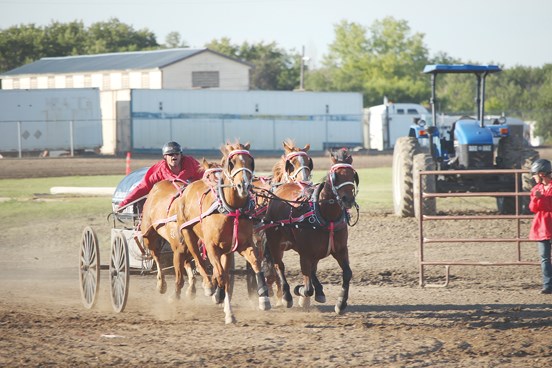When it comes to agriculture the equine sector sometimes seems to get lost.
The sector is often seen more as a hobby, or perhaps falling into the realm of sport, than an agriculture enterprise, and there are some obvious reasons for being unsure exactly what box to check in terms of horses.
But what should not be lost is the significant impact the horse industry has on our economy.
The impact was brought into sharp focus again last week when attending the Yorkton Exhibition Association’s summer fair.
Each day I drove down the road at the back of the grounds right through the middle of the parking for those involved in chuckwagon and chariot races.
It is an impressive site seeing the semi-trailer units, horse trailers and campers sprawled across the grass, and the horse tethered out awaiting a chance to run the track.
In talking to Kevin Gareau president of the Eastern Professional Chariot & Chuckwagon Association (EPCCA), I learned that there were 45 chuckwagons entered in the Yorkton show, and 53 chariots. A bit of math and I realized that would account for 286 horses on the grounds, add a few more carried as extras, or training purposes and it is easy to suggest 300 horses were on-site.
Gareau said a young horse for racing might be purchased for $2,500, but the best were about $10,000. If you average that at a modest $5,000 the value of horses for racing in Yorkton was $1.5 million.
Of course the horses, while the single most important component of racing, are only a small part of the cost of what is very much a hobby for drivers, but also an economic stimulator.
Every hitch requires a wagon and harness, the horses need feed. A farrier will be needed to shoe the horses. On occasion a veterinarian will be required.
And that is just to run the track.
Drivers in the EPCCA come from all over the province. Gareau as an example is from Domreny, SK., which according to Google is about a 350 kilometre jaunt from Yorkton.
Rolling a truck and trailer down the highway means gas purchases, flat tires that need fixing, and dozens of other pop up costs drivers will face as Gareau noted they hit some 18 communities for 40 days of racing each summer.
There is also of course the cost of the trailers, many manufactured on the Prairies, and of trucks, and campers, barbecues and tarps and a hundred other things chuckwagon drivers and their families will require for life on the road from June through September each year.
While the horse industry is not the critical aspect of farming it once was, it does remain a sector which sees dollars spreading through the local economy, with the chuckwagon and chariot sector a clear example of that.
Calvin Daniels is Editor With Yorkton This Week.



